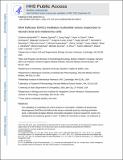RNA helicase DDX21 mediates nucleotide stress responses in neural crest and melanoma cells
Author(s)
Santoriello, Cristina; Sporrij, Audrey; Yang, Song; Flynn, Ryan A; Henriques, Telmo; Dorjsuren, Bilguujin; Custo Greig, Eugenia; McCall, Wyatt; Stanhope, Meredith E; Fazio, Maurizio; Superdock, Michael; Lichtig, Asher; Adatto, Isaac; Abraham, Brian J; Kalocsay, Marian; Jurynec, Michael; Zhou, Yi; Adelman, Karen; Calo, Eliezer; Zon, Leonard I; ... Show more Show less
DownloadAccepted version (3.979Mb)
Publisher Policy
Publisher Policy
Article is made available in accordance with the publisher's policy and may be subject to US copyright law. Please refer to the publisher's site for terms of use.
Terms of use
Metadata
Show full item recordAbstract
© 2020, The Author(s), under exclusive licence to Springer Nature Limited. The availability of nucleotides has a direct impact on transcription. The inhibition of dihydroorotate dehydrogenase (DHODH) with leflunomide impacts nucleotide pools by reducing pyrimidine levels. Leflunomide abrogates the effective transcription elongation of genes required for neural crest development and melanoma growth in vivo1. To define the mechanism of action, we undertook an in vivo chemical suppressor screen for restoration of neural crest after leflunomide treatment. Surprisingly, we found that alterations in progesterone and progesterone receptor (Pgr) signalling strongly suppressed leflunomide-mediated neural crest effects in zebrafish. In addition, progesterone bypasses the transcriptional elongation block resulting from Paf complex deficiency, rescuing neural crest defects in ctr9 morphant and paf1(alnz24) mutant embryos. Using proteomics, we found that Pgr binds the RNA helicase protein Ddx21. ddx21-deficient zebrafish show resistance to leflunomide-induced stress. At a molecular level, nucleotide depletion reduced the chromatin occupancy of DDX21 in human A375 melanoma cells. Nucleotide supplementation reversed the gene expression signature and DDX21 occupancy changes prompted by leflunomide. Together, our results show that DDX21 acts as a sensor and mediator of transcription during nucleotide stress.
Date issued
2020Department
Whitehead Institute for Biomedical Research; Massachusetts Institute of Technology. Department of Biology; Koch Institute for Integrative Cancer Research at MITJournal
Nature Cell Biology
Publisher
Springer Science and Business Media LLC